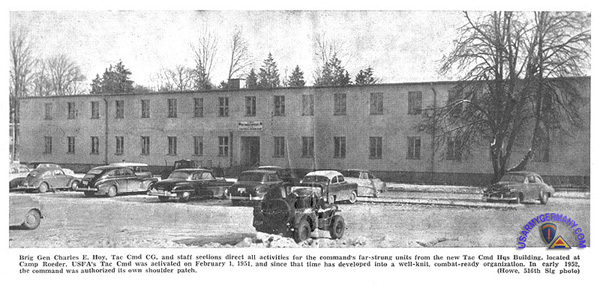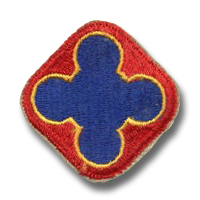If you do NOT see the Table of Contents frame to the left of this page, then
Click here to open 'USArmyGermany' frameset |
Tactical Command
U.S. Forces, Austria
Looking for more information from military/civilian
personnel assigned to or associated with the U.S. Forces, Austria from 1945 to 1955. If you have any
stories or thoughts on the subject, please contact me . .
|
|
|
|
|
| |
| Tactical Command
History |
| |
| 1952 |
| (Source: ARMY NAVY & AIR FORCE JOURNAL, 23 February, 1952) |
Austria Tactical Command
A new shoulder sleeve insignia, incorporating the colors symbolic of the three basic combat arms, has been approved by the Army for use by the Tactical Command, U.S. Forces Austria.
Described as "a red square, with rounded corners, outlined in yellow, formed by four discs centered on the diagonals of the square and overlapping a larger central disc; worn with one point of the square up," the new insignia replaces the old 88th Division patch now in use by the 350th Infantry Regiment and the USFA patch worn by other tactical command units.
The USFA patch, a shield of red and white vertical stripes with a blue sword and olive branch, will continue to be worn by headquarters and service units of USFA.
Tactical Command, headed by Brig. Gen. James C. Fry, USA, includes the following units:
  350th Infantry Regiment 350th Infantry Regiment
  4th Armored Reconnaissance Battalion 4th Armored Reconnaissance Battalion
  11th AAA Battalion 11th AAA Battalion
  510th Field Artillery Battalion 510th Field Artillery Battalion
  77th Field Artillery Battery 77th Field Artillery Battery
  70th Engineer Construction Battalion 70th Engineer Construction Battalion
  532nd Engineer Combat Company 532nd Engineer Combat Company
  518th Engr. Combat Company 518th Engr. Combat Company
  7613th Flight Section 7613th Flight Section
  516th Signal Company 516th Signal Company
  7621 Headquarters and Service Company 7621 Headquarters and Service Company
  USFA NCO Academy USFA NCO Academy |
|
|

HQ Tactical Command, Camp Roeder, 1953 |
| |
| 1953 |
(Source: Command Briefing published ca. 1953) |
When Zone Command Austria, a headquarters responsible for post administration and training of tactical troops, was discontinued on 1 June 1950, it soon became apparent that an intermediate headquarters was required to train and command tactical troops.
Major General Paul W. Kendall, then Deputy Commanding General, USFA, aware of this requirement, directed that selected members of the General Staff Sections of Headquarters, USFA be utilized as a nucleus for the formation of such a headquarters. This group of officers and men participated in the first field exercises of the headquarters in July 1950 under the command of General Kendall. Brigadier General Morrill Marston served as Deputy Commander and Lt Colonel S.D. Smith was the first Chief of Staff of this provisional headquarters. In early August 1950, Colonel Lionel C. McGarr was designated by CG, USFA as a special coordinator for the training of the provisional headquarters. On 23 August, the new headquarters, then referred to as Tactical Command, successfully met its first field test by planning and conducting a joint US-French Maneuver in the U.S. Zone of Austria. In this maneuver, Tactical Command also served as Director of Headquarters.
Until 31 October 1951, officers and men participated in field problems with Tactical Command twice monthly on a hit or miss basis. Required personnel were picked from where they could be found and impressed into service for each field problem. Consequently, except for a small cadre of officers from each staff section, there was no one section or group organized and trained to function as a coordinated team. Moreover, there was no Table of Allowances for the procurement of equipment which was necessary for the functioning of the headquarters in the field. The fact that officers serving in Tactical Command were required to perform their primary duties in the USFA Staff Sections to which assigned made it extremely difficult to plan for succeeding maneuvers and maintain equipment properly between field problems.
On 31 October 1950, USFA Staff Memorandum No. 31 announced that Headquarters, USFA would be organized into three echelons:
_____(a) Tactical Command
_____(b) USFA Forward
_____(c) USFA Rear
The mission of Tactical Command was to assume operational control of such units and personnel as would be assigned and to carry out missions as prescribed by the Commanding General, USFA. Concurrently, a memorandum which included the names of the officers who were to be considered as assigned to Tactical Command was published.
On 3 March 1950, the Commanding General, USFA, approved in principle a recommendation to reorganize USFA by establishment of three separate posts and the organization of Tactical Command as a separate headquarters under Headquarters, USFA. The committee appointed to formulate the implementation plans rendered its final report on 20 December 1950.
On 13 January 1951, Headquarters, USFA, published General Order No. 1 which organized the 7620th Headquarters, Tactical Command and the 7621st Headquarters Company, Tactical Command with a combined authorized strength of 27 officers, 2 warrant officers and 95 enlisted men. The mission of TACTICAL COMMAND was stated as follows:
"To organize and train the Tactical element of United States Forces in Austria in order to provide a disciplined, fully equipped and effective fighting force capable of closing on the enemy by fire and maneuver in order to capture or destroy him, or repel his assault by fire and close combat."
On 31 January 1951, Headquarters, USFA, published Special Order No. 22 which assigned Brigadier General James C. Fry as Commanding General, Tactical Command effective 1 February 1951. Shortly prior to this assignment, General Fry met with the staff section chiefs of Headquarters, USFA to determine specific officers and men who would be transferred to Tactical Command.
Immediately upon assumption of Command, General Fry issued well calculated directives which fixed staff responsibilities and established sound standard operating procedures. Upon completion of this basic organization period, General Fry, recognizing that he had not been given certain administrative authority and disciplinary powers so essential to command, proceeded to obtain same by forceful representation to the Commanding General, USFA. This action by which he obtained authority for transfers, promotions, issuance of travel orders, court-martial jurisdiction, a distinctive shoulder patch, the addition of a Judge Advocate Section, Surgeon Section, Military Police Company and an increase in the enlisted strength of 7621 Headquarters Company, Tactical Command gained for him great confidence and respect from his staff and contributed immeasurably to the combat readiness of the Tactical Units in Austria.
During the period from activation date to the present date, Tactical Command has grown in strength from approximately 4,000officers and men to over 8,000 and, in additiona to field problems, participated in the following maneuvers:
_____(a) EXERCISE ALPINE, from 14-20 January 1951
_____(b) EXERCISE REBOUND, from 19-26 May 1951
_____(c) EXERCISE SNOWSHOE, January 1952
_____(d) EXERCISE FROSTY, November 1953
Since Tactical Command has been in existence, it has had 4 commanders - Gen Fry, Col Barlow, Gen Freeman and the present commander Gen Hoy. . |
|
|
| |
| (Source: USFA SENTINEL, Feb 5, 1954) |
USFA'S TACTICAL COMMAND
OBSERVES THIRD ANNIVERSARY
While not as large as a division, Tac Cmd is a balanced fighting force whose major component units are the 350th Inf, 4th Rcn Bn, 510th FA Bn, 11th AAA Bn, 70th Engr Bn, and the 188th Med Bn. Activated only three years ago, Tac Cmd itself can boast no combat record. Its units, however, have fought in many parts of the world and can claim battle honors dating back almost a century.
The 350th Inf was reactivated as a component of the 88th Inf Div in July, 1942, at Camp Gruber, Okla. After completion of training in the US and North Africa, the division was moved to Italy in January, 1944. The 88th was the first organized reserve division to go overseas and the first to enter combat in World War II. Committed to action north of Naples in March, 1944, in what was later known as the Rome-Arno Campaign, the 350th was the first Allied unit to enter Rome. Spearheading the Fifth Army's drive north of Florence, the 350th captured strategic Monte Battaglia or "Battle Mountain." Consolidating positions on Battaglia, the 350th repelled attack after attack by strong German forces for seven consecutive days. For the achievement of holding this mountain despite 50 percent casualties, the 2nd Bn, 350th Inf, received the Presidential Unit Citation.
The 4th Rcn Bn, for its action against the enemy in December, 1944, at Bogheim, Germany, was awarded the Distinguished Unit Streamer.
The 70th Engr Bn served during World War II as the 2nd Bn, 35th Engr Regt, and as the 145th Engr Bn. The battalion received the Meritorious Unit Streamer for its work on the Alcan Highway and in Europe. |
|
|
| |
| (Source: USFA SENTINEL, July 22, 1955) |
Ceremony Marks Tactical Command Closing
Tac Cmd's colors were retired here last Friday with extensive ceremony, marking "Closed" for another unit in keeping with the phase-out program now under way. Highlighted by a final retreat parade, the inactivation rites included farewell messages from the former commanding general of the combat arm, Brig Gen Charles E. Hoy, and Lt Gen William H. Arnold, USFA CG, both of whom warmly commended the troops for their achievements.
As the Tac Cmd standard was saluted for the last time, 11 guns fired a volley, laying it to rest. |
 |
|
| |
Related Links:
|
| |
| |
|

